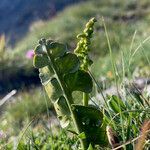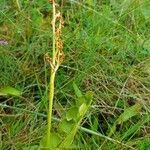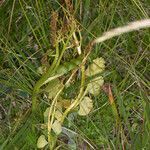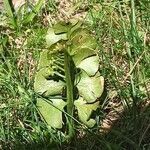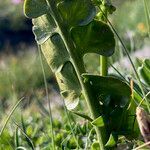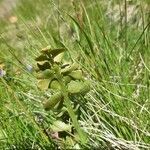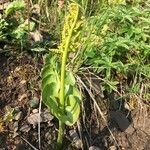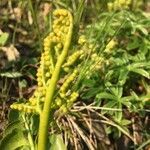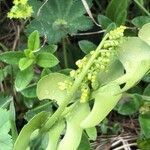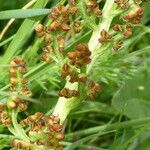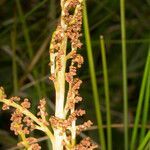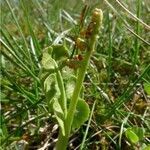Rhizomes short, erect, annually producing 1 frond 5-15 (-25) cm tall. Common stipe greenish, cylindrical, 4-12 cm, 2-3 mm in diam., hollow, succulent. Sterile lamina pinnate, sessile, broadly lanceolate or oblong, 3-8 × 1.5-2.5 cm, fleshy, leathery, glabrous, apex rounded or blunt; pinnae 4-6 pairs, approximate, often overlapping, opposite or almost opposite, flabellate (fan-shaped), lunate, or reniform, 1-1.5(-2) cm long and wide, shortly stalked to almost sessile, lowest 1 or 2 pairs 1-2 cm apart, margin entire, crenate, or incised; veins free, flabellately forked, glabrous. Sporophore with stalk 4-7 cm, glabrous; panicle 2-or 3-pinnate, racemose, 3-6 × 1.5-2 cm, glabrous; sporangia sessile, large, 0.5-1 mm in diam. Spores yellowish, surface verrucose. 2n = 90.
Trophophore stalk 0--1 mm; blade dark green, oblong, 1-pinnate, to 10 × 4 cm, thick, fleshy. Pinnae to 9 pairs, spreading, mostly overlapping except in shaded forest forms, distance between 1st and 2d pinnae not or slightly more than between 2d and 3d pairs, basal pinna pair approximately equal in size and cutting to adjacent pair, broadly fan-shaped, undivided to tip, margins mainly entire or undulate, rarely dentate, apical lobe usually cuneate to spatulate, notched, approximate to adjacent lobes, apex rounded, venation like ribs of fan, midribs absent. Sporophores 1--2-pinnate, 0.8--2 times length of trophophore. 2 n =90.
Rhizome erect, 1–2 cm long; roots few, slender. Fronds 2.5–18 cm tall, fleshy. Common stipe 1–7 cm long. Sterile lamina sessile, ovate to oblong, 8–70 mm long, 6–28 mm wide, comprising 2-6 pairs of opposite flabellate pinnae. Pinnae 3–10 mm long, 4.5–16 mm wide; margins entire, crenate or more rarely deeply incised. Sporophore on a stipe 10–75 mm long, arising from near the base of the lowermost pinnae pair of the sterile lamina, 2-pinnately compound, rarely simple. Sporangia yellow, drying pale brown.
Stipes stout; fronds 7-15 cm. tall, us. solitary; sterile seg. simply pinnate, pinnae 3-6-jugate, broad-flabellate to semi-circular or lunate. Sporangia close-set, yellowish.
